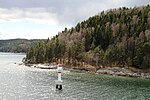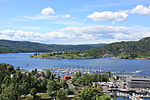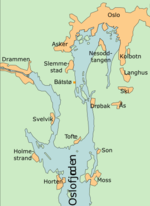Battle of Drøbak Sound

The Battle of Drøbak Sound took place in Drøbak Sound, the northernmost part of the outer Oslofjord in southern Norway, on 9 April 1940. It marked the end of the "Phoney War" and the beginning of World War II in Western Europe. A German fleet led by the cruiser Blücher was dispatched up the Oslofjord to begin the German invasion of Norway, with the objective of seizing the Norwegian capital of Oslo and capturing King Haakon VII and his government. The fleet was engaged in the fjord by Oscarsborg Fortress, an aging coastal installation near Drøbak, that had been relegated to training coastal artillery servicemen, leading the Germans to disregard its defensive value. However, unbeknownst to German military intelligence, the fortress' most powerful weapon was a torpedo battery, which would be used to great effect against the German invaders.The fortress' armaments worked flawlessly despite their age, sinking the Blücher in the sound and forcing the German fleet to fall back. The loss of the German flagship, which carried most of the troops and Gestapo agents intended to occupy Oslo, delayed the German occupation long enough for King Haakon VII and his government to escape from the capital.
Excerpt from the Wikipedia article Battle of Drøbak Sound (License: CC BY-SA 3.0, Authors, Images).Battle of Drøbak Sound
Kyststien, Frogn
Geographical coordinates (GPS) Address Nearby Places Show on map
Geographical coordinates (GPS)
| Latitude | Longitude |
|---|---|
| N 59.7009 ° | E 10.5927 ° |
Address
Nordøstre Askeskjær naturreservat
Kyststien
1454 Frogn
Norway
Open on Google Maps







